ThisiscontentfromElsevier'sDrugInformation
Varenicline
Learn more about Elsevier's Drug Information today! Get the drug data and decision support you need, including TRUE Daily Updates™ including every day including weekends and holidays.
0.5 mg PO once daily on days 1 to 3, then 0.5 mg PO twice daily on days 4 to 7, and then 1 mg PO twice daily for a total of 12 weeks. An additional 12 weeks of treatment for a total of 24 weeks is recommended for successful quitters to increase likelihood of long-term abstinence. Another attempt at treatment is recommended for those who fail to stop smoking or relapse when factors contributing to the failed attempt have been addressed.[32296]
0.03 mg (1 spray) in each nostril twice daily, approximately 12 hours apart.[67052] [71210]
2 mg per day PO; 0.12 mg (4 sprays) intranasally per day.
2 mg per day PO; 0.12 mg (4 sprays) intranasally per day.
Safety and efficacy have not been established.
Safety and efficacy have not been established.
Safety and efficacy have not been established.
Safety and efficacy have not been established.
No dosage adjustment is necessary for patients with hepatic impairment.[32296]
CrCl 30 mL per minute or more: No dosage adjustment needed.
CrCl less than 30 mL per minute: Initially, 0.5 mg PO once per day. Max: 0.5 mg PO twice daily.[32296]
Intermittent hemodialysis
Varenicline is removed by hemodialysis. A maximum dose of 0.5 mg PO once daily may be given if well tolerated in patients with end-stage renal disease on hemodialysis.[32296]
† Off-label indication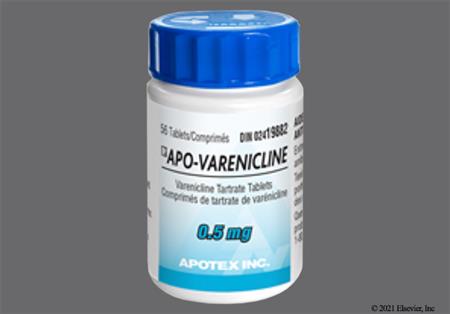
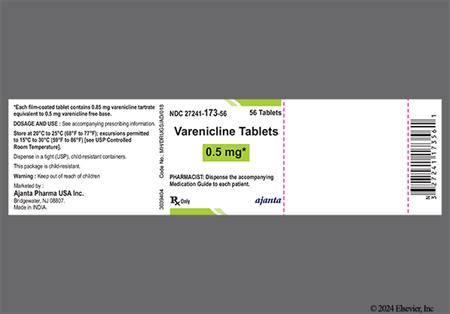

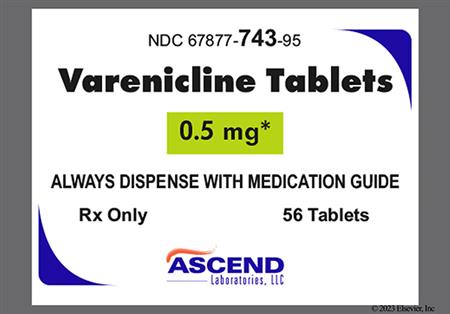
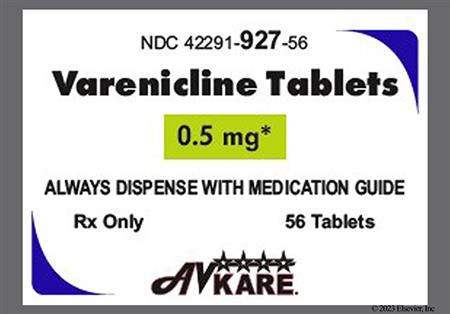





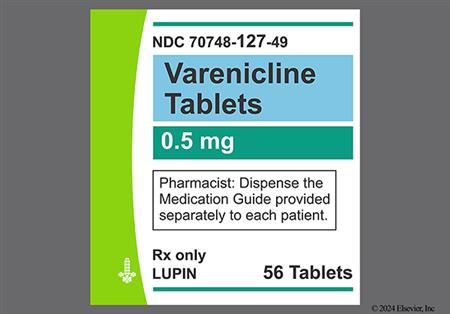
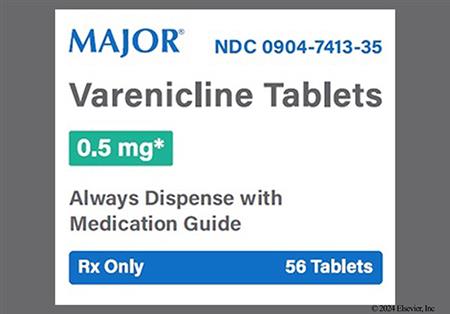

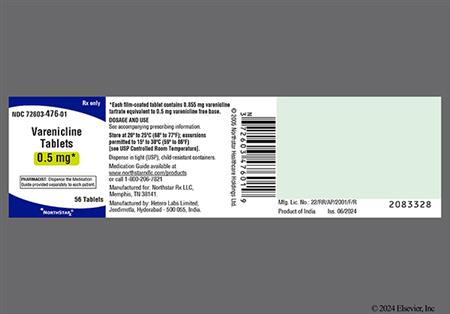

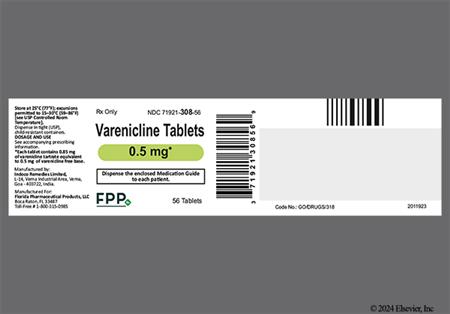
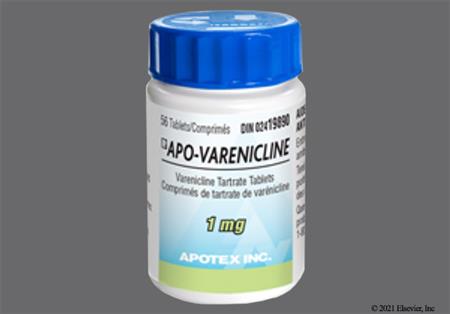
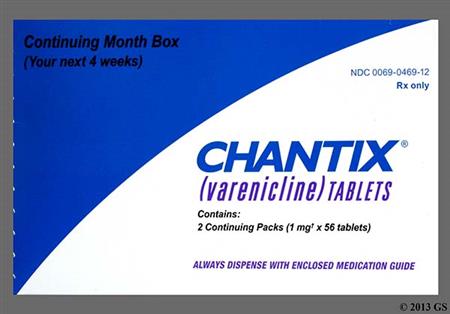

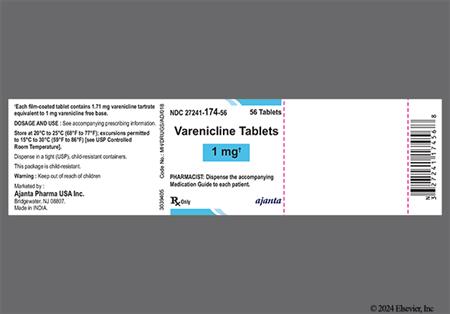


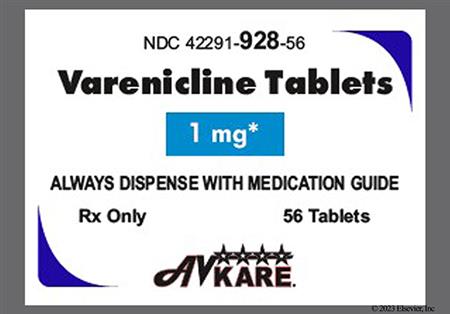
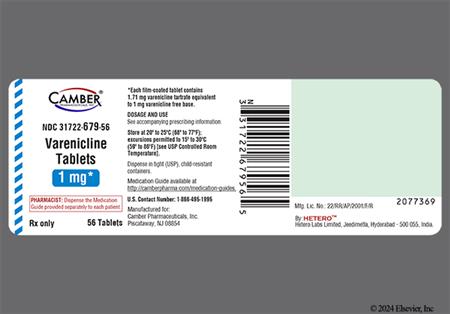

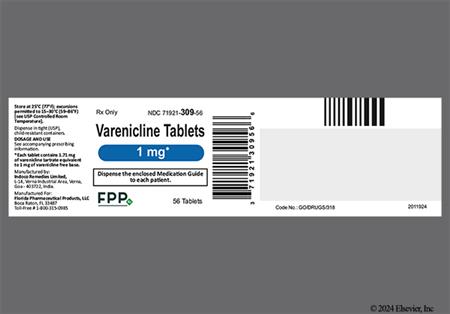
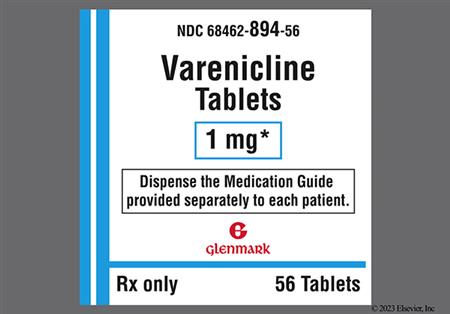
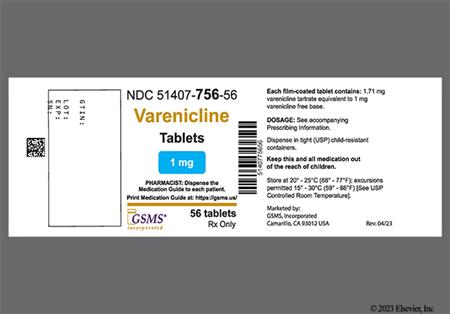
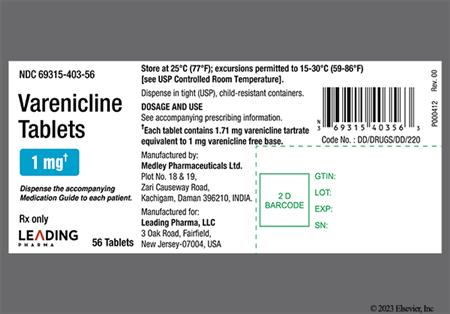
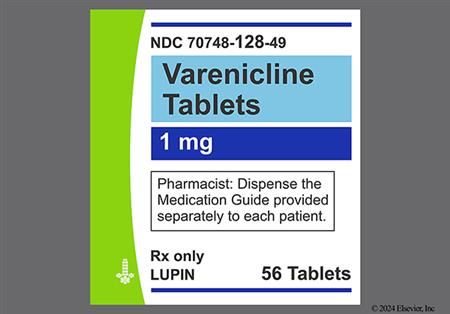

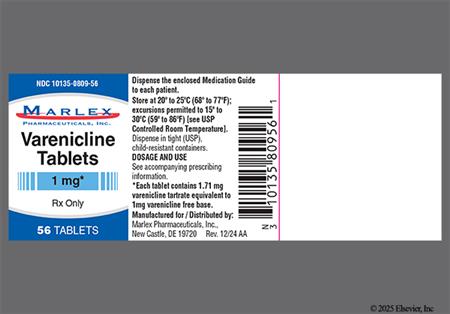
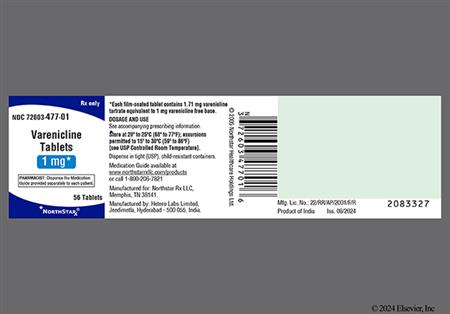
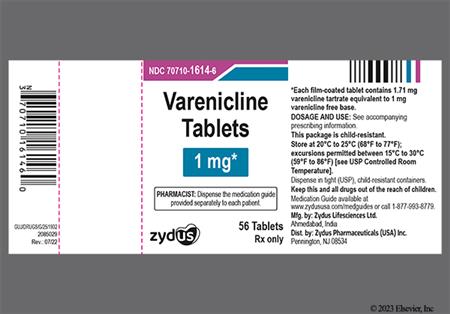
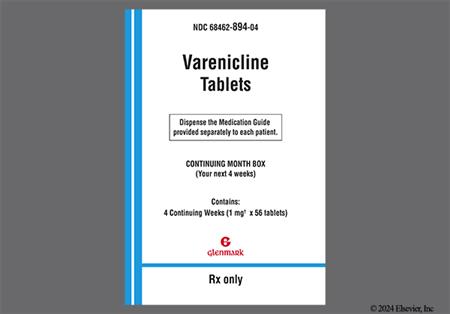
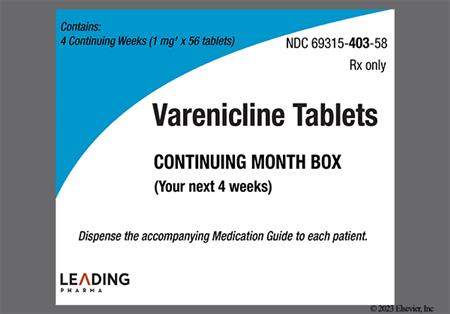
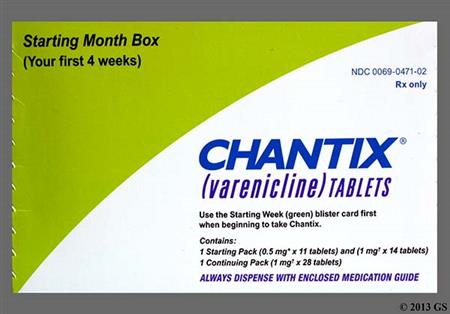
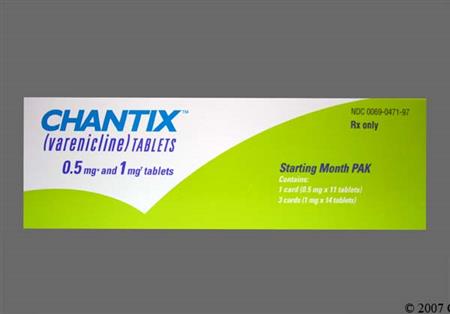

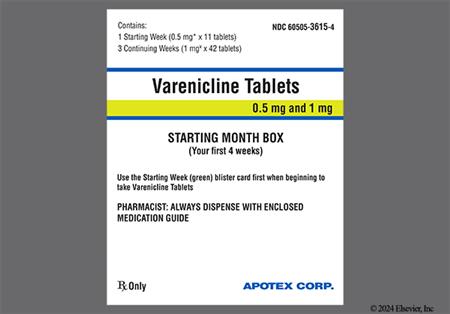
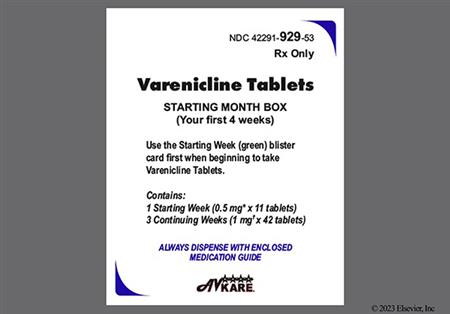
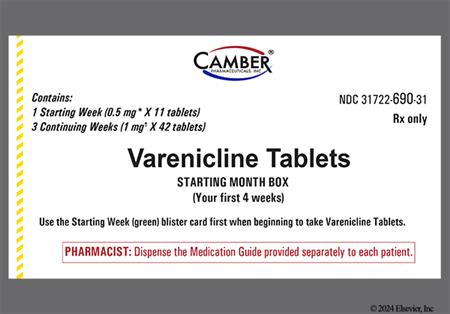


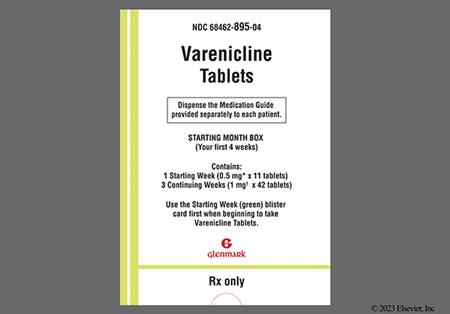
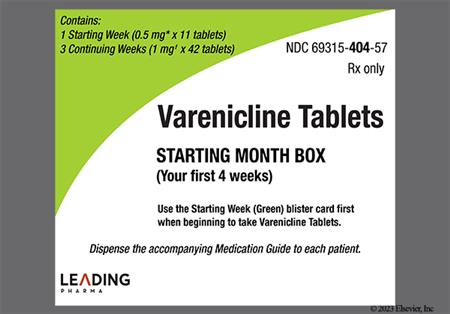

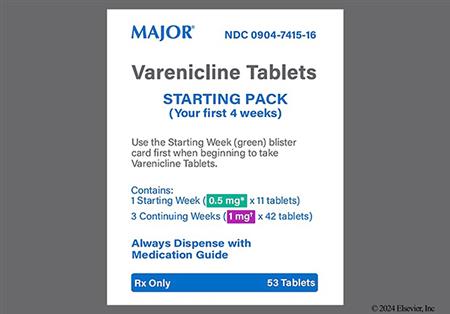
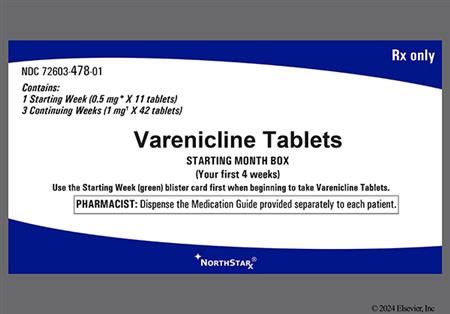
Varenicline is a nicotinic acetylcholine receptor agonist. The nasal spray is used for the treatment of signs and symptoms associated with dry eye disease.[67052] Oral varenicline is used to aid in smoking cessation. For smoking cessation, varenicline is effective because it provides some nicotine effects to help with nicotine withdrawal symptoms while also blocking the effects of nicotine if the user were to relapse. Most other smoking cessation therapies either try to replace nicotine or mimic the effects of nicotine by inhibiting dopamine reuptake. Varenicline was evaluated in 3,659 chronic smokers (about 21 cigarettes per day for 25 years) in 6 premarketing clinical trials.[32296] In 5 of the clinical trials, patients treated with varenicline were more successful than those receiving placebo.[32296] In 2 of the 5 studies, varenicline-treated patients were more successful than patients treated with bupropion; nausea was a frequent side effect during treatment.[32429][32430] In a large placebo-controlled study evaluating subjects who were not able or willing to quit smoking within 4 weeks, but were willing to gradually reduce their smoking over 12 weeks before quitting, a 50% reduction in the number of cigarettes smoked occurred in varenicline treated patients. After 24 weeks of treatment followed by post-treatment assessments through week 52, subjects in the varenicline group had a significantly higher Continuous Abstinence Rate (CAR) compared with those receiving placebo at weeks 15 through 24 and weeks 15 through 52.[32296] In a study evaluating the safety and efficacy of varenicline in 460 patients with mild to moderate chronic obstructive pulmonary disease (COPD), varenicline was more effective than placebo in helping patients quit smoking and remain abstinent for as long as 1 year.[32296] Oral varenicline is not recommended for pediatric patients for smoking cessation, as in one study varenicline did not improve continuous abstinence rates at weeks 9 through 12 of treatment compared to placebo when studied in pediatric subjects 12 to 17 years of age. The safety profile of varenicline was similar to that of adults.[32296] Varenicline is essentially unmetabolized and has no clinically significant metabolic drug interactions. However, behavioral changes and neuropsychiatric events may occur in some patients.[32296][46658] Varenicline was initially FDA-approved in 2006.
NOTE: Globally, as well as in the U.S., all lots of oral varenicline of the brand name Chantix were recalled from the market in 2021 because they contained unacceptable levels of a nitrosamine, N-nitroso-varenicline, at or above the FDA interim acceptable intake limit. Long-term ingestion of N-nitroso-varenicline may be associated with a theoretical potential increased cancer risk in humans. In some cases, generic versions of oral varenicline remain marketed as an alternative to oral Chantix.[66891]
For storage information, see the specific product information within the How Supplied section.
Tablets
Nasal Spray
Nausea is the most frequently reported adverse effect of oral varenicline, and is generally transient and considered mild to moderate in severity. However, it may persist for several months in some patients and a dose reduction may be necessary in some cases. For patients with intolerable nausea, a dose reduction should be considered.[32296] During a one-year study, nausea was reported in up to 40% of varenicline-treated patients and at rates exceeding placebo. In a placebo-controlled trial of patients with stable schizophrenia or schizoaffective disorder, nausea (24%) and vomiting (11%) were reported more frequently in patients receiving oral varenicline than placebo. During 12-week placebo-controlled clinical trials comparing varenicline 0.5 to 1 mg PO twice daily to placebo, the following gastrointestinal (GI) effects were reported more frequently in the varenicline groups than with placebo: nausea (16% to 30%), abdominal pain (5% to7%), flatulence (6% to 9%), dyspepsia (5%), vomiting (1% to 5%), constipation (5% to 8%), gastroesophageal reflux (1%), xerostomia (4% to 6%), dysgeusia (5% to 8%), appetite stimulation (3% to 4%), and anorexia or decreased appetite (1% to 2%). Nausea was responsible for treatment discontinuation in 3% of patients. In a clinical trial of adults with stable schizophrenia or schizoaffective disorder, nausea (24%) and vomiting (11%) occurred more frequently in patients treated with varenicline than placebo. In other clinical trials, nausea was observed in 27% of adults with major depressive disorder and 25% of patients with or without a history of a psychiatric disorder treated with varenicline. During other evaluations, diarrhea and weight gain were classified as frequent. Infrequent effects included dysphagia, enterocolitis, eructation, esophagitis, gastritis, GI bleeding (hemorrhage), and oral ulceration. Rare effects included peptic ulcer, intestinal GI obstruction, and acute pancreatitis.[32296]
During 12-week placebo-controlled clinical trials comparing varenicline 0.5 mg to 1 mg PO twice daily to placebo, the following centrally-mediated (CNS) effects were reported more frequently in the varenicline groups than the placebo group: headache (15% to 19%), drowsiness (3%), lethargy (1% to 2%), fatigue (4% to 7%), insomnia (18% to 19%), abnormal dreams (9% to 13%), sleep disorder (2% to 5%), and nightmares (1% to 2%). In a placebo-controlled trial of patients with stable schizophrenia or schizoaffective disorder, CNS events occurring in 5% or more of patients and more frequently than placebo were insomnia (10%) and headache (11%). In adults with major depressive disorder, the following adverse CNS effects occurred more frequently in patients treated with varenicline than placebo: headache (17%), abnormal dreams (11%), and insomnia (11%). In a separate clinical trial, the following CNS effects were reported more frequently in adults receiving oral varenicline than placebo in cohorts with or without a history of a psychiatric disorder, respectively: headache (12% each varenicline group), sleep disorder (3% each varenicline group), insomnia (9% vs. 10%), and abnormal dreams (12% vs. 8%). During other clinical trial evaluations, disturbance in attention, dizziness, and sensory disturbance were classified as frequent. Infrequent effects included amnesia, migraine, parosmia, psychomotor hyperactivity or restlessness, restless legs syndrome (RLS), and tremor. Rare effects included balance disorder, dysarthria, facial palsy, mental impairment (unspecified), multiple sclerosis, and psychomotor impairment. There have been postmarketing reports of accidental injuries including motor vehicle accidents, near-miss traffic incidents, and other accidental injuries during the use of oral varenicline. In some cases, patients experienced drowsiness, dizziness, loss of consciousness, or difficulty concentrating that resulted in cognitive impairment, or concern about potential impairment, in driving or operating machinery. Patients should be advised to use caution when driving or operating machinery or performing other tasks that require mental alertness until they know how varenicline will affect them. In addition, complex sleep-related behaviors, including somnambulism (sleep-walking) have been reported in patients taking varenicline, with some cases describing harmful behavior to self, others, or property. Seizures have also been reported in patients with and without a seizure disorder treated with varenicline during clinical trials and postmarketing experience. In most cases, the seizure occurred within the first month of therapy. Patients should be advised to discontinue varenicline and contact a healthcare provider immediately if they experience a seizure, complex sleep-related behaviors (e.g., somnambulism), or other serious effects while on treatment.[32296]
Orally administered varenicline has been studied for the frequency of psychiatric events occurring in patients with or without specific psychiatric history. In a clinical trial of adults with stable schizophrenia or schizoaffective disorder, there were no commonly reported adverse psychiatric events with varenicline treatment. In a clinical trial of adults with major depressive disorder, the following adverse psychiatric events were reported more frequently in patients receiving varenicline than placebo: irritability (11%), depression (depressed mood disorders or disturbances 11%), agitation (7%), tension (4%), and hostility (2%). In a separate clinical trial, the following psychiatric events were reported more frequently in adults receiving varenicline in cohorts with or without a history of a psychiatric disorder, respectively: agitation (5% vs. 3%), depressed mood (5% vs. 3%), and irritability (5% vs. 3%). Anxiety (8%) occurred more frequently in the active treatment group vs. placebo only in the cohort of patients with a history of psychiatric disorder (8%). The manufacturer categorizes some treatment-emergent adverse reactions occurring during varenicline clinical trials as frequent, infrequent, or rare; however, a precise incidence rate for these events has not been reported. Psychiatric effects classified as infrequent include disorientation, dissociation, libido decrease, mood swings (emotional lability), and abnormal thinking. Bradyphrenia and euphoria are classified as rare. Mania, psychosis, hallucinations, paranoia, delusions, homicidal ideation, aggression, agitation, hostility, anxiety, panic, and depression have been reported during postmarketing use of oral varenicline. These adverse effects have developed within days to weeks of starting therapy, and may occur in patients with or without an underlying psychiatric disorder. Additionally, some reported neuropsychiatric events, including unusual and sometimes aggressive behavior directed to oneself or others, may have been worsened by concomitant use of alcohol. There have been postmarketing reports of patients experiencing increased ethanol intoxication while taking varenicline. Some cases described unusual and sometimes aggressive behavior, and were often accompanied by amnesia for the events. Patients should be advised to reduce alcohol ingestion while taking varenicline until they know whether the drug affects their alcohol tolerance.[32296]
Serious skin reactions, including Stevens-Johnson syndrome and erythema multiforme, have occurred during postmarketing use of oral varenicline, and can be life-threatening. Other dermatological adverse reactions have been reported with varenicline use. During 12-week placebo-controlled clinical trials comparing oral varenicline 0.5 to 1 mg twice daily to placebo, the following dermatologic effects were reported in the varenicline groups versus the placebo group: rash (1% to 3% vs 2%) and pruritus (up to 1% vs 1%). During other clinical trial evaluations, hyperhidrosis and hot flashes (hot flush) were classified as frequent; however, the exact incidences are unknown. Infrequent effects included acne vulgaris, xerosis, atopic dermatitis, erythema, psoriasis, and urticaria. Photosensitivity was classified as rare. Patients should be instructed to discontinue the drug if they develop any rash with mucosal lesions or other skin reaction and to seek immediate medical attention.[32296]
There have been postmarketing reports of hypersensitivity reactions, including angioedema, in patients treated with oral varenicline. Clinical signs included swelling of the face, mouth (tongue, lips, and gums), extremities, and neck (throat and larynx, laryngeal edema). There were infrequent reports of life-threatening angioedema requiring emergent medical attention due to respiratory compromise. Patients should be instructed to discontinue the drug and to immediately seek medical attention if they experience these symptoms.[32296]
A meta-analysis of data from 7,002 patients found that major adverse cardiovascular events (MACE) including cardiovascular-related death, nonfatal myocardial infarction (MI), and nonfatal stroke occurred at a higher numerical rate in patients using oral varenicline compared to placebo. However, the overall incidence was low in both groups and was not statistically significant (0.31% vs. 0.21% placebo). This is similar to an estimated increase of 6.3 MACE per 1,000 patient-years of exposure. In addition, although not statistically significant, the incidence of cardiovascular mortality and all-cause mortality was lower in patients receiving varenicline than placebo.[52585] These results are consistent with those from a trial of patients with stable cardiovascular disease (n = 700), in which more types and a greater number of cardiovascular events were reported compared to premarketing studies. In the trial of patients with stable cardiovascular disease, the following cardiovascular effects occurred in more than 1% of patients in the active treatment group and more frequently than placebo during the 12-week treatment phase or within 30 days after treatment: angina (3.7%), chest pain (unspecified) (2.5%), peripheral edema (2%), and nonfatal MI (1.1%). During the 40-week non-treatment follow-up phase, the following events occurred more frequently in patients treated with oral varenicline than placebo: need for coronary revascularization (2%), hospitalization for angina (1.7%), and new diagnosis of peripheral vascular disease (PVD) or admission for a PVD procedure (1.1%). Cardiac death occurred in 0.3% of varenicline-treated patients versus 0.6% of placebo-treated patients.[32296] Infrequent treatment-emergent adverse events (TEAEs) occurring during varenicline clinical trials include syncope, arrhythmia (unspecified), bradycardia, palpitations, sinus tachycardia, ventricular extrasystoles, abnormal electrocardiogram, and thrombosis, and rare TEAEs include atrial fibrillation, atrial flutter, coronary artery disease, cor pulmonale, and pulmonary embolism. Ischemic and hemorrhagic stroke and MI have been reported during postmarketing use. Most patients experiencing these events had pre-existing cardiovascular disease or other risk factors. Although smoking is a risk factor for MI and stroke, these events have occurred temporally to varenicline administration; therefore, an association to the drug cannot be ruled out.[32296]
The manufacturer categorizes some treatment-emergent adverse reactions occurring during oral varenicline clinical trials as frequent, infrequent, and rare. The incidence of these adverse reactions has not been reported by the manufacturer. Musculoskeletal and connective tissue disorders classified as frequent included arthralgia, back pain, muscle cramps, musculoskeletal pain, and myalgia. Infrequent effects included arthritis, osteoporosis, and increased creatine phosphokinase (CPK) enzymes. Myositis was classified as rare.[32296]
The manufacturer categorizes some treatment-emergent adverse reactions occurring during oral varenicline clinical trials as frequent, infrequent, or rare. The incidence of these adverse reactions has not been reported. The following reproductive system disorders are classified as follows: menstrual irregularity (frequent), sexual dysfunction (infrequent), and impotence (erectile dysfunction) (rare).[32296]
The manufacturer categorizes some treatment-emergent adverse reactions occurring during oral varenicline clinical trials as frequent, infrequent, and rare. The incidence of these adverse reactions has not been reported by the manufacturer. Renal and urinary effects classified as frequent include polyuria. Infrequent effects include nephrolithiasis, nocturia, urethral syndrome, urine abnormality, and abnormal urinalysis. Acute renal failure (unspecified) and urinary retention are classified as rare.[32296]
The manufacturer categorizes some treatment-emergent adverse reactions occurring during oral varenicline clinical trials as frequent, infrequent, or rare. The incidence of these adverse reactions has not been reported. Endocrine effects classified as infrequent include thyroid gland disorders (unspecified) and diabetes mellitus with hyperglycemia. Hypoglycemia is classified as rare.[32296]
Some treatment-emergent adverse reactions occurring during oral varenicline clinical trials have been reported by the manufacturer as frequent, infrequent, or rare; the incidence of these adverse reactions has not been reported. Infrequent ocular/visual treatment-emergent adverse reactions include conjunctivitis, xerophthalmia, ocular irritation, ocular pain, blurred vision, and visual impairment. Acquired night blindness, transient blindness, subcapsular cataracts, ocular vascular disorder, photophobia, vitreous floaters, nystagmus, and visual field defect have also rarely been reported with oral varenicline use.[32296] The FDA is investigating the potential association between varenicline administration and visual disturbances. The FDA received notification of this possible association via the Adverse Event Reporting System (AERS); however, a causal relationship has not been determined at this time.
The manufacturer categorizes some treatment-emergent adverse reactions occurring during oral varenicline clinical trials as frequent, infrequent, or rare. The incidence of these adverse reactions has not been reported. Otic and labyrinth effects classified as infrequent include tinnitus and vertigo. Hearing loss (deafness) and Meniere's disease are classified as rare.[32296]
During 12-week placebo-controlled clinical trials comparing varenicline 0.5 to 1 mg PO twice daily to placebo, the following respiratory effects were reported more frequently in the varenicline groups than the placebo group: rhinorrhea (up to 1% vs 0%), dyspnea (1% to 2% vs 1%), and upper respiratory tract disorder (5% to 7% vs 4%). During other clinical trial evaluations, epistaxis and respiratory disorder (unspecified) were classified as frequent. Infrequent effects included asthma (bronchospasm). Pleurisy was classified as a rare effect.[32296]
The manufacturer categorizes some treatment-emergent adverse reactions occurring during oral varenicline clinical trials as frequent, infrequent, or rare. The incidence of these adverse reactions has not been reported. Hematologic and lymphatic effects classified as infrequent include anemia and lymphadenopathy. Leukocytosis, splenomegaly, and thrombocytopenia are classified as rare.[32296]
The manufacturer categorizes some treatment-emergent adverse reactions occurring during oral varenicline clinical trials as frequent, infrequent, or rare. The incidence of these adverse reactions has not been reported. General effects not listed elsewhere and classified as frequent include edema and influenza-like illness. Chest discomfort, chills, fever, hypokalemia, and hyperlipidemia are classified as infrequent.[32296]
The manufacturer categorizes some treatment-emergent adverse reactions occurring during oral varenicline clinical trials as frequent, infrequent, or rare. The incidence of these adverse reactions has not been reported. Elevated hepatic enzymes are classified as frequent. Gall bladder disorder (e.g., cholecystitis) is classified as rare.[32296]
Suicidal ideation and attempted/completed suicide have been reported during postmarketing use of oral varenicline. The FDA conducted a postmarketing safety review of data from 1997 to 2007 in the Adverse Event Reporting System (AERS) and found that varenicline was associated with 153 cases of suicidal ideation and behaviors. Of these cases, 76 patients had a prior psychiatric history, 40 patients had no prior psychiatric history, and the psychiatric history was unknown in 37 patients. The median time to onset of symptoms was less than 2 weeks after varenicline initiation. Depression was a co-morbid event in 50% of patients at the time of the reporting, and concomitant psychiatric medications were being used by 39% of the patients. Of the cases considered serious (n = 147), outcomes were categorized as follows: death (13%), hospitalization (13%), life-threatening (21%), disability (6%), intervention required (4%), and other (76%). It should be noted that these outcomes were not mutually exclusive. The FDA subsequently conducted two epidemiological studies which found no difference between hospitalizations due to neuropsychiatric events in patients receiving varenicline compared to nicotine replacement therapy; however, the study designs were limited to hospitalizations and the sample sizes were not sufficient to detect rare events.[46658] In an independent analysis of 13,243 documented cases of adverse events involving smoking cessation products, there were 3249 reports of self-injurious behaviors and/or depression of which varenicline use was associated with 90% of those cases compared to bupropion (7%) or nicotine replacement products (3%). There were 295 reports of completed suicides (2.2% of total events) involving smoking cessation products in which the vast majority were associated with varenicline use (92%) compared to bupropion (6%) or nicotine replacement (1%). Self-injurious behaviors and/or depression were reported in 1% of patients (n = 48/4,047) in the comparator group who had received antibiotics.[46673] Although patients with schizophrenia, bipolar disorder, and major depression were excluded from premarketing clinical trials, there is limited data available regarding the potential risk of suicidal ideation from a smoking cessation study in patients with stable schizophrenia or schizoaffective disorder. A meta-analysis of 5 randomized, double-blind, placebo controlled trials, including 1,907 patients (1,130 varenicline, 777 placebo) was conducted to assess suicidal ideation and behavior as reported on the Columbia-Suicide Severity Rating Scale (C-SSRS). In 1 small (n = 128) trial, no consistent worsening of schizophrenia or overall changes in extra-pyramidal signs were reported. Although over half of the patients had a lifetime history of suicidal behavior and/or ideation (62% on varenicline vs. 51% on placebo), no patients in the varenicline group reported suicidal behavior and/or ideation at baseline vs. one patient in the placebo group (2%). Suicidal behavior and/or ideation were reported in 11% of the varenicline-treated compared to 9% of the placebo-treated patients during the treatment phase. During the post-treatment phase, suicidal behavior and/or ideation were reported in 11% of patients in the varenicline group and 5% of patients in the placebo group. Many of the patients reporting suicidal behavior and ideation in the follow-up phase had not reported such experiences in the treatment phase. However, no new suicidal ideation or behavior emerged in either treatment group within one week after treatment discontinuation. Although there were no completed suicides, there was one suicide attempt in a varenicline-treated patient. Another trial (n = 525) included patients with a history of depression. The results showed no increase in the incidence of suicidal ideation and/or behavior in patients treated with varenicline compared to patients treated with placebo (RR 0.79, 95% CI 0.46, 1.36). Forty-eight of the 55 patients who reported suicidal ideation or behavior (24 varenicline, 24 placebo) were observed in the two trials that enrolled patients with a history of schizophrenia, schizoaffective disorder, or depression. Few events were observed in the other 3 trials (4 varenicline, 3 placebo). A pooled analysis of 18 double-blind, randomized, placebo-controlled clinical trials, which includes the 5 trials that collected C-SSRS, was conducted to assess the psychiatric safety of oral varenicline. This pooled analysis included 8,521 patients (5,072 varenicline, 3,449 placebo), some of whom had psychiatric conditions at baseline. The results showed a similar incidence of common psychiatric events in patients treated with oral varenicline compared to patients treated with placebo. Four observational studies, each including 10,000 to 30,000 users of oral varenicline in the adjusted analyses, compared the risk of selected serious neuropsychiatric events (neuropsychiatric hospitalizations, fatal and non-fatal self-harm), between varenicline users and prescription NRT or bupropion users. All studies were retrospective cohort studies and included patients with and without a psychiatric history. Two of the studies found no difference in risk of neuropsychiatric hospitalizations between varenicline users and nicotine patch users (HR: 1.14, 95% CI: 0.56 to 2.34 in the first study, and 0.76, 95% CI: 0.40 to 1.46 in the second study). It should be noted that neither study validated the diagnostic codes used to identify outcomes against medical records. A third study reported no difference in risk of psychiatric adverse events diagnosed during an ER visit or inpatient admission between oral varenicline users and bupropion users (HR: 0.85, 95% CI: 0.55 to 1.30). A fourth study examined risk of fatal and non-fatal self-harm in users of varenicline compared to users of NRT. Although the occurrence of detected suicide was rare during the 3 months after patients initiated any drug treatment (2 cases in 31,260 varenicline users and 6 cases in 81,545 NRT users). This study was limited by several factors, including the fact that these data were captured following public awareness of reports of neuropsychiatric adverse events in varenicline users. Varenicline users had fewer comorbid conditions that could put them at risk for neuropsychiatric adverse events, suggesting that patients with a history of neuropsychiatric illness were preferentially prescribed NRT, and healthier patients were preferentially prescribed oral varenicline. Outcomes examined in these studies did not include the full range of neuropsychiatric adverse events that have been reported during postmarketing use of varenicline, therefore, extreme caution is advisable when using varenicline in those with an underlying psychiatric disorder until the safety and efficacy of varenicline can be formally established in these patient populations. Smoking cessation alone is associated with nicotine withdrawal and has the potential to exacerbate an underlying psychiatric illness. However, not all patients experiencing adverse neuropsychiatric reactions while taking varenicline have had pre-existing psychiatric illness and not all had stopped smoking at the time of the event; therefore, it is currently recommended that all patients receiving varenicline should be monitored for emerging or worsening neuropsychiatric symptoms. Patients and caregivers should be instructed about the importance of monitoring for neuropsychiatric symptoms, and advised to discontinue varenicline and to communicate immediately with the prescriber the emergence of agitation, depression, unusual changes in moods or behavior, or suicidality, or other adverse changes in mood or behavior. A change or discontinuation of the therapeutic regimen should be considered if these symptoms are severe, abrupt in onset, or were not part of the patient's presenting symptoms.[32296]
The most frequently reported adverse reaction following administration of varenicline nasal spray during clinical trials was sneezing (82%). Other common adverse reactions included cough (16%), throat irritation (13%), and nasal irritation (8%).[67052]
The coadministration of certain medications may lead to harm and require avoidance or therapy modification; review all drug interactions prior to concomitant use of other medications.
This medication is contraindicated in patients with a history of hypersensitivity to it or any of its components.
Neuropsychiatric adverse events, including suicidality, have occurred with oral varenicline treatment in people with and without a pre-existing psychiatric disorder; some patients experienced worsening of their pre-existing psychiatric illnesses. People receiving oral varenicline should be closely monitored for behavior changes or alterations in mood (including depression or mania), psychosis, aggression, agitation, suicidal ideation, and suicide attempts. Some symptoms, including aggression, were made worse with concomitant use of alcohol. Some patients who stopped smoking may have been experiencing symptoms of nicotine withdrawal, including depressed mood. Depression, rarely including suicidal ideation, has been reported in smokers undergoing a smoking cessation attempt without medication. However, some of these adverse events occurred in oral varenicline recipients who continued to smoke. Varenicline should be discontinued and the health care provider contacted immediately if agitation, depression, changes in behavior or thinking are observed that are not typical for the patient are observed, or if the patient develops suicidal ideation or behavior. Evaluate the severity of symptoms and the extent to which the patient is benefiting from treatment and consider dose reduction, continued treatment under closer monitoring, or discontinuation of treatment. In many cases, symptoms have resolved following discontinuation of varenicline. However, symptoms have persisted in some cases, and ongoing monitoring and supportive care should be provided until the symptoms resolve.[32296]
Oral varenicline recipients should be advised to use caution when driving or operating machinery or performing other activities requiring coordination and concentration until they know how varenicline will affect them. There have been reports of motor vehicle accidents, near-miss traffic incidents, and other accidental injuries during the use of orally administered varenicline. In some cases, varenicline recipients have experienced drowsiness, dizziness, loss of consciousness, or difficulty concentrating that resulted in impairment, or concern about potential impairment, in driving or operating machinery. Cases of somnambulism have also been reported during treatment; discontinue varenicline if somnambulism occurs. Additionally, treated patients should be advised to reduce their quantity of ethanol ingestion until they know whether oral varenicline affects their tolerance for alcohol. There have been postmarketing reports of patients experiencing increased intoxicating effects of alcohol while taking oral varenicline. Some neuropsychiatric adverse events, including unusual and sometimes aggressive behavior directed to oneself or others, may have been worsened by concomitant use of alcohol, and were often accompanied by amnesia for the events.[32296]
Consider the risk:benefit ratio when oral varenicline treatment is considered for individuals with a history of seizures, a seizure disorder, or with factors that can lower the seizure threshold. Seizures have been reported in patients treated with oral varenicline during clinical trials and postmarketing experience. Some varenicline recipients had no history of seizures, whereas others had a history of a seizure disorder that was remote or well-controlled. In most cases, the seizure occurred within the first month of therapy. Instruct patients to discontinue varenicline and contact a health care provider immediately if they experience a seizure while on treatment.[32296]
An evaluation of randomized controlled trials and meta-analyses suggests that oral varenicline may be associated with a small, increased risk of certain cardiovascular events, such as myocardial infarction or stroke, in people with cardiovascular disease. Smoking is an established independent major risk factor for cardiovascular disease, and the health benefits of smoking cessation must be considered when balancing potential medication risk. In a smoking cessation trial of patients with stable cardiac disease, nonfatal myocardial infarction and nonfatal stroke occurred more frequently with varenicline than placebo, but the difference was not statistically significant, and all-cause and cardiovascular mortality was lower in patients receiving varenicline. A meta-analysis showed an increased hazard ratio of 1.95 for Major Adverse Cardiovascular Events (MACE) with varenicline, which was not statistically significant. A large postmarketing neuropsychiatric safety study reported few MACE events; therefore, the findings did not significantly contribute to the understanding of the cardiovascular risk of varenicline treatment.[32296] [52585]
Use oral varenicline with caution in people with renal impairment or renal failure. Varenicline is substantially excreted by the kidneys and the risk of toxic reactions is greater in people with impaired renal function. Dosage adjustments of oral varenicline are necessary in people with severe renal impairment (CrCl less than 30 mL/minute) and those with end-stage renal disease receiving hemodialysis. No dose adjustment is necessary in people with mild to moderate renal impairment.[32296]
Available data from orally administered varenicline have not suggested an increased risk for major birth defects after drug exposure during pregnancy, compared with pregnant individuals who smoke tobacco. However, available studies cannot definitively establish or exclude any varenicline-associated risk during pregnancy. In a population-based observational study of national registries from Denmark and Sweden comparing people exposed to oral varenicline, people who smoked tobacco during pregnancy, and non-smoking pregnant people, the prevalence of major malformations was similar in all groups. The prevalence of other adverse perinatal outcomes in the varenicline-exposed cohort was not greater than in the cohort of those who smoked. Study limitations included the inability to capture malformations from pregnancies without a live birth and potential data misclassification. Other small epidemiological studies did not identify an association between oral varenicline use during pregnancy and major malformations. Methodological limitations of these studies include small samples and lack of adequate controls. Smoking tobacco during pregnancy causes increased risks of orofacial clefts, premature rupture of membranes, placenta previa, placental abruption, ectopic pregnancy, fetal growth restriction and low birth weight, stillbirth, preterm delivery and shortened gestation, neonatal death, sudden infant death syndrome and reduction of lung function in infants. It is not known whether varenicline use for smoking cessation during pregnancy reduces these risks.[32296] Non-pharmacologic tobacco and nicotine cessation efforts are used to help reduce the proportion of people who use these substances during pregnancy and to reduce adverse perinatal outcomes. Cessation at any point in gestation benefits the pregnant person and their fetus; the greatest benefit is observed with cessation before 15 weeks gestation. Nicotine replacement treatment is used during pregnancy only if the likelihood of smoking cessation justifies the potential risk of nicotine treatment or the risk that the patient will continue to smoke. Varenicline is not a first-line choice for smoking cessation due to a need for more data.[42078] [72483] There are no data on the use of nasal varenicline (for dry eye treatment) during human pregnancy to inform any drug-associated risk. The patient's systemic exposure after nasal use is only about 7.5% of concentrations achieved with oral use. In animal reproduction studies, varenicline did not produce malformations at clinically relevant doses. Maternal toxicity, characterized by reduced body weight gain and reduced fetal weights occurred in rabbits at the highest dose (4,864 times the maximum recommended human dose).[67052]
Use varenicline with caution during breast-feeding. There are no data on the presence of varenicline in human milk, its effects on the breastfed child, or its effects on milk production.[32296] [67052] However, based on its small molecular weight, low protein binding, and long half-life, it is likely to transfer to human milk. Maternal drug exposure after using varenicline nasal spray is only about 7.5% that of the oral drug, so the spray is less likely to affect the child than oral dosing. Because no definitive safety data are available on the use of varenicline during breast-feeding, an alternate drug is usually preferred, especially while breast-feeding a newborn or preterm infant. Limited animal data suggest that varenicline may interfere with normal infant lung development. If varenicline use is required during breast-feeding, monitor the breastfed child for changes in sleep or feeding, vomiting, and seizures.[70364] [70365] The decision to use a pharmacologic method for smoking cessation during breast-feeding should be evaluated in comparison to the risks associated with passive exposure of the child to tobacco smoke. Nicotine replacement products may be considered as an alternate smoking cessation treatment to varenicline in breast-feeding individuals if supportive cessation interventions are ineffective. Nicotine does pass into breast milk; lower strength and shorter-acting nicotine products are preferred during breast-feeding.[70364] [72335]
Varenicline is a partial agonist of nicotinic acetylcholine (nACh) receptors alpha4-beta2, alpha4alpha6-beta2, alpha3-beta4, alpha3alpha5-beta4, and full alpha7. These receptors are believed to be the site whereby nicotine exerts its effects. Similar to most abused substances, nicotine increases dopamine release in the nucleus accumbens and prefrontal cortex. Cravings for nicotine are stimulated by low levels of mesolimbic dopamine during periods of abstinence. Varenicline is effective because it partially stimulates alpha4-beta2 receptors to produce a modest level of mesolimbic dopamine thereby diminishing nicotine cravings and withdrawal symptoms. This mesolimbic dopamine level is lower than that produced by nicotine. Varenicline also has the added benefit of blocking the effects of nicotine by occupying receptor sites. By blocking receptors, varenicline reduces the pharmacologic reward of nicotine in cases where a patient relapses and uses tobacco. Varenicline binds with high affinity and selectivity to these nACh receptors. Varenicline also binds with moderate affinity to 5-HT3 (serotonin) receptors.
The exact mechanism by with varenicline treats the symptoms of dry eye disease is unknown; however, it is believed to occur through binding to the heteromeric sub-type(s) of nACh receptors. By binding to these receptors, varenicline activates the trigeminal parasympathetic pathway resulting in increased production of basal tear film.[67052]
Revision Date: 07/29/2025, 03:14:05 PMVarenicline is administered orally and intranasally. Twenty percent or less of varenicline is plasma protein bound and is independent of both age and renal function. Metabolism is minimal. Approximately 92% of an administered dose is excreted unchanged in the urine. Elimination via the kidneys is primarily through glomerular filtration along with active tubular secretion by the human organic cation transporter, OCT2. The elimination half-life is about 24 hours for the oral formulation and 19 hours +/- 10 hours for the intranasal formulation.[32296][67052]
Affected cytochrome P450 isoenzymes and drug transporters: none
Based on in vitro studies, varenicline does not inhibit cytochrome P450 enzymes 1A2, 2A6, 2B6, 2C8, 2C9, 2C19, 2D6, 2E1, and 3A4/5. It does not induce CYP1A2 or CYP3A4.[32296]
Varenicline is almost completely absorbed, and systemic availability is high with oral administration. The maximum plasma concentration (Cmax) occurs within 3 to 4 hours and steady-state is reached in about 4 days after multiple doses. Food or time-of-day do not affect varenicline oral bioavailability.[32296]
Following nasal administration of 0.12 mg (i.e., 0.06 mg spray in each nare), varenicline was detected in the plasma within 5 minutes and achieved peak concentration within 2 hours. The mean Cmax and systemic exposure (AUC) were 0.34 ng/mL and 7.46 ng x hour/mL, respectively. The AUC following the 0.12 mg intranasal dose was approximately 7.5% of the exposure observed following a 1 mg oral dose.[67052]
Because varenicline is not hepatically metabolized, the pharmacokinetics of varenicline are not affected by hepatic impairment.[32296]
In patients with moderate (CrCl 30 to 49 mL/minute) to severe (CrCl less than 30 mL/minute) renal impairment, systemic exposure to varenicline was increased 1.5- and 2.1-fold, respectively, compared to patients with normal renal function (CrCl more than 80 mL/minute). End-stage renal disease (ESRD) patients receiving 0.5 mg PO once daily for 12 days and undergoing a 3-hour hemodialysis session 3 days a week had a 2.7-fold increase in varenicline systemic exposure. The varenicline plasma Cmax and AUC in these ESRD patients were similar to those seen in healthy subjects receiving about 1 mg PO twice daily. Varenicline is efficiently removed by hemodialysis.[32296]
Steady-state systemic exposure (AUC) in adolescent patients weighing more than 55 kg was comparable to that noted in the adult population. Mean exposure was approximately 40% higher in adolescent patients weighing 55 kg or less.[32296]
Based on pharmacokinetic studies and population pharmacokinetic analyses, no clinically meaningful differences exist in varenicline pharmacokinetics due to age.
Based on pharmacokinetic studies and population pharmacokinetic analyses, no clinically meaningful differences exist in varenicline pharmacokinetics due to gender.
Based on pharmacokinetic studies and population pharmacokinetic analyses, no clinically meaningful differences exist in varenicline pharmacokinetics due to race.
Based on pharmacokinetic studies and population pharmacokinetic analyses, no clinically meaningful differences exist in varenicline pharmacokinetics due to smoking status or use of concomitant medications.
Available data from orally administered varenicline have not suggested an increased risk for major birth defects after drug exposure during pregnancy, compared with pregnant individuals who smoke tobacco. However, available studies cannot definitively establish or exclude any varenicline-associated risk during pregnancy. In a population-based observational study of national registries from Denmark and Sweden comparing people exposed to oral varenicline, people who smoked tobacco during pregnancy, and non-smoking pregnant people, the prevalence of major malformations was similar in all groups. The prevalence of other adverse perinatal outcomes in the varenicline-exposed cohort was not greater than in the cohort of those who smoked. Study limitations included the inability to capture malformations from pregnancies without a live birth and potential data misclassification. Other small epidemiological studies did not identify an association between oral varenicline use during pregnancy and major malformations. Methodological limitations of these studies include small samples and lack of adequate controls. Smoking tobacco during pregnancy causes increased risks of orofacial clefts, premature rupture of membranes, placenta previa, placental abruption, ectopic pregnancy, fetal growth restriction and low birth weight, stillbirth, preterm delivery and shortened gestation, neonatal death, sudden infant death syndrome and reduction of lung function in infants. It is not known whether varenicline use for smoking cessation during pregnancy reduces these risks.[32296] Non-pharmacologic tobacco and nicotine cessation efforts are used to help reduce the proportion of people who use these substances during pregnancy and to reduce adverse perinatal outcomes. Cessation at any point in gestation benefits the pregnant person and their fetus; the greatest benefit is observed with cessation before 15 weeks gestation. Nicotine replacement treatment is used during pregnancy only if the likelihood of smoking cessation justifies the potential risk of nicotine treatment or the risk that the patient will continue to smoke. Varenicline is not a first-line choice for smoking cessation due to a need for more data.[42078] [72483] There are no data on the use of nasal varenicline (for dry eye treatment) during human pregnancy to inform any drug-associated risk. The patient's systemic exposure after nasal use is only about 7.5% of concentrations achieved with oral use. In animal reproduction studies, varenicline did not produce malformations at clinically relevant doses. Maternal toxicity, characterized by reduced body weight gain and reduced fetal weights occurred in rabbits at the highest dose (4,864 times the maximum recommended human dose).[67052]
Use varenicline with caution during breast-feeding. There are no data on the presence of varenicline in human milk, its effects on the breastfed child, or its effects on milk production.[32296] [67052] However, based on its small molecular weight, low protein binding, and long half-life, it is likely to transfer to human milk. Maternal drug exposure after using varenicline nasal spray is only about 7.5% that of the oral drug, so the spray is less likely to affect the child than oral dosing. Because no definitive safety data are available on the use of varenicline during breast-feeding, an alternate drug is usually preferred, especially while breast-feeding a newborn or preterm infant. Limited animal data suggest that varenicline may interfere with normal infant lung development. If varenicline use is required during breast-feeding, monitor the breastfed child for changes in sleep or feeding, vomiting, and seizures.[70364] [70365] The decision to use a pharmacologic method for smoking cessation during breast-feeding should be evaluated in comparison to the risks associated with passive exposure of the child to tobacco smoke. Nicotine replacement products may be considered as an alternate smoking cessation treatment to varenicline in breast-feeding individuals if supportive cessation interventions are ineffective. Nicotine does pass into breast milk; lower strength and shorter-acting nicotine products are preferred during breast-feeding.[70364] [72335]
Cookies are used by this site. To decline or learn more, visit our cookie notice.
Copyright © 2025 Elsevier, its licensors, and contributors. All rights are reserved, including those for text and data mining, AI training, and similar technologies.